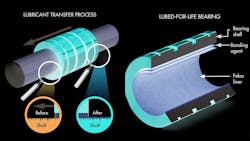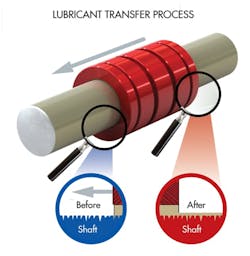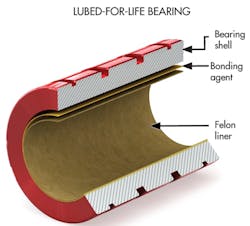This article was updated April 19, 2023. It was originally published Aug. 31, 2017.
RELATED
Four Lubrication Mistakes that can Bring Machines Down
The Best Bearing Lubrication System May be None at All
Some companies that make bearings and linear guides toss around terms like “self‐lubrication,” “maintenance free” and “lubed for life” a little too loosely. They likely know that many engineers and designers think those terms mean one thing while they and their marketers are using completely different definitions. This miscommunication creates confusion and could possibly lead engineers to use bearings not really suitable for their applications. The end result could be failure, equipment damage, maintenance and downtime, as well as bottom-line losses in productivity and profits.
There are devices such as oil-impregnated seals and wipers, along with lubrication reservoirs and felt wicks, that can extend a bearing’s life and improve performance. They cannot be classified as “self‐lubricating” or “maintenance free,” however. They still require maintenance to add or replace oil that dissipates, ages and becomes ineffective over time.
To be “lubed for life” requires that the lubricant, usually PTFE, be an integral part of the original bearing material. The lubrication cannot be an add‐on; it must be part of the bearing’s makeup for its entire life. When the bearing moves across the shaft, rail or other mating surface, it transfers microscopic amounts of material to that mating surface. The material creates a lubricating film that reduces friction over the length of the mating surface.
The transfer process continues throughout the self-lubricating bearing’s operational life. The process begins with a break‐in period and the initial transfer of material. The amount of bearing material deposited on the mating surface depends on several factors, including the speed, load and length of stroke. The break-in period typically lasts only 50 to 100 continuous operational strokes or revolutions.
After the break-in is done, the mating surface is lubricated but material transfer continues. It deposits and maintains a microscopic film on the shaft, especially in the valleys of the mating surface.
Some clever advertising gimmicks and inaccurate training materials claim “self‐lubricating” or “lubed for life” capabilities for components that do not fit the definition. Here’s a look at some often-mislabeled types of components.
Rolling element devices. These include linear, ball and roller bearings which all need external lubrication to operate. It lets the bearings overcome the metal‐to-metal contact and friction generated when they rotate on a shaft or against another surface such as a rail. If there is no lubrication, the bearings rub against the shaft or rail and causes galling and brinelling damage to both the shaft/rail and bearing. It can also lead to catastrophic overheating.
Many manufacturers add oil impregnated seals to the ends of bearings or housings. This approach extends the life of the bearing but does not mean lubed for life.
Oil impregnated bronze bearings. The bronze is porous and the bearings are soaked in lightweight oil, some of which seeps into the bronze. The oil gets drawn to the surface of the bearing when it is being used. There, it creates a lubricating film between the bearing and shaft. But eventually all the “stored” oil is used and must be replenished or the bearing replaced.
Oil impregnated plastics. As with the impregnated bronze, plastic bearings and components are soaked in lightweight oil, which does provide lubrication, initially. But eventually the oil runs out or degrades over time and lubrication ceases.
Graphite plugged bronze bearings. Graphite is a solid lubricant that is usually added to linear bronze bearings. Solid plugs of graphite inserted into holes in the bearing provide lubrication as long as they remain. But they get worn down before the bearing is at the end of its operational life.
PTFE coated bearings. PTFE (Teflon) can be applied to bearing surfaces several different ways. It can be dusted onto them as a powder; put into a mixture and sprayed on; or it can be part of a liquid or grease applied to them. All of these methods create a thin layer of lubricant that gets quickly worn away.
Self-Lubricating Criteria
Self-lubricating bearings must provide their own lubrication throughout their operational life and never need an automated or manual lubrication source or a reservoir that must be replenished. Lubrication that does not break down over time must be designed into the material formed into the bearing.
In other words, “self‐lubricating” must ensure clean and maintenance‐free operation in the most challenging environments. Designers need to learn to recognize the difference between various lubrication options. Failure to do so will result in costly misapplications and re‐designs.


